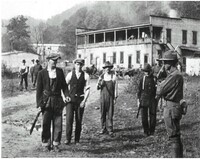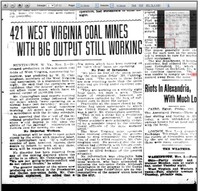Items
-
 Log boom constructed by the St. Lawrence Boom and Manufacturing Company on the Greenbrier River, near Ronceverte, Greenbrier County, WV.
Splash dam on the Guyandotte River, Raleigh County, WV, 1907. During the dry summer months, logging companies constructed splash dams on streams. These dams held back water until stream levels were high enough to float logs. When the dam gates opened, the rushing water carried logs downstream. To help loggers direct and sort the floating timber, booms caught and held logs as they traveled downriver to sawmills. The booms consisted of two main parts: 1) “cribs” made from logs stacked in a square-shaped tower and anchored with huge rocks, and 2) “strings” of logs chained together to create a floating barrier and connect the cribs. According to one local historian, most boom companies in West Virginia “went up the creek into bankruptcy” once railroads replaced waterways as the principal way of moving logs to the mills.
Log boom constructed by the St. Lawrence Boom and Manufacturing Company on the Greenbrier River, near Ronceverte, Greenbrier County, WV.
Splash dam on the Guyandotte River, Raleigh County, WV, 1907. During the dry summer months, logging companies constructed splash dams on streams. These dams held back water until stream levels were high enough to float logs. When the dam gates opened, the rushing water carried logs downstream. To help loggers direct and sort the floating timber, booms caught and held logs as they traveled downriver to sawmills. The booms consisted of two main parts: 1) “cribs” made from logs stacked in a square-shaped tower and anchored with huge rocks, and 2) “strings” of logs chained together to create a floating barrier and connect the cribs. According to one local historian, most boom companies in West Virginia “went up the creek into bankruptcy” once railroads replaced waterways as the principal way of moving logs to the mills. -
 A logging crew along the Little River, near Bartow, Pocahontas County, WV. Working six days per week, often ten or more hours a day, crews of workers known as “wood hicks” cut and prepared hundreds of logs each day for transport to a sawmill. At the peak of West Virginia’s timber boom in 1909, men with job titles like choppers, sawyers, swampers, and knot bumpers earned between $1.75 and $2.00 per day.
A logging crew along the Little River, near Bartow, Pocahontas County, WV. Working six days per week, often ten or more hours a day, crews of workers known as “wood hicks” cut and prepared hundreds of logs each day for transport to a sawmill. At the peak of West Virginia’s timber boom in 1909, men with job titles like choppers, sawyers, swampers, and knot bumpers earned between $1.75 and $2.00 per day. -
 Maggie Hammons Parker at home in Stillwell, near Marlinton, Pocahontas County, West Virginia. The influence of the Hammons family on West Virginia folk life spans generations. However, wide recognition of their songs, stories, and traditions did not come until the 1970s when local musician Dwight Diller became closely acquainted with the Hammonses. Diller learned their music, practiced their traditions, and studied their history. His relationship with the Hammonses triggered interest among other musicians and folklorists, and his field recordings and interviews contributed to a study of the family produced by the Library of Congress in 1973. The Hammonses are recognized as central to the preservation of authentic musical styles and culture in the region. Recordings of their music have been released by WVU Press, the Library of Congress, Rounder Records, Dwight Diller, and the Augusta Heritage Center of Davis & Elkins College. Pictured here, Maggie Hammons Parker was a matriarch of the family and one of five Hammonses inducted into the West Virginia Music Hall of Fame in 2020.
Maggie Hammons Parker at home in Stillwell, near Marlinton, Pocahontas County, West Virginia. The influence of the Hammons family on West Virginia folk life spans generations. However, wide recognition of their songs, stories, and traditions did not come until the 1970s when local musician Dwight Diller became closely acquainted with the Hammonses. Diller learned their music, practiced their traditions, and studied their history. His relationship with the Hammonses triggered interest among other musicians and folklorists, and his field recordings and interviews contributed to a study of the family produced by the Library of Congress in 1973. The Hammonses are recognized as central to the preservation of authentic musical styles and culture in the region. Recordings of their music have been released by WVU Press, the Library of Congress, Rounder Records, Dwight Diller, and the Augusta Heritage Center of Davis & Elkins College. Pictured here, Maggie Hammons Parker was a matriarch of the family and one of five Hammonses inducted into the West Virginia Music Hall of Fame in 2020. -
 Pete, Paris, and Neal Hammons Taken in 1906 along the Williams River in Webster County, this photograph features members of the Hammons family—brothers Pete, Paris, and Neal—posing with a fiddle, gun, and phonograph. Known for their distinctive old-time musical sound, their knowledge of mountain lore, and their traditional way of life, the Hammons family embodies the culture and sound of the West Virginia frontier. According to folklorist and musician Gerry Milnes, “The three brothers seem to be making a calculated statement by holding items of importance and usefulness.” Milnes notes that the inclusion of the phonograph “belies any argument that this family was musically isolated from the rest of the world,” contradicting the stereotype of mountaineers as culturally secluded from the rest of the world.
Pete, Paris, and Neal Hammons Taken in 1906 along the Williams River in Webster County, this photograph features members of the Hammons family—brothers Pete, Paris, and Neal—posing with a fiddle, gun, and phonograph. Known for their distinctive old-time musical sound, their knowledge of mountain lore, and their traditional way of life, the Hammons family embodies the culture and sound of the West Virginia frontier. According to folklorist and musician Gerry Milnes, “The three brothers seem to be making a calculated statement by holding items of importance and usefulness.” Milnes notes that the inclusion of the phonograph “belies any argument that this family was musically isolated from the rest of the world,” contradicting the stereotype of mountaineers as culturally secluded from the rest of the world. -
 Subscription School Students and Teachers, West Virginia. Though often viewed by the popular press as backward and isolated, historians have consistently shown that Appalachia was connected to the broader national economy and culture. Often following the lead of middle-class reformers, many residents came to believe that both education and industrial development were essential to the advancement of the region. As part of their pursuit of education, some rural communities offered subscription singing schools where adults and children could learn to sing using a form of written music called “shape notes.” Families paid a subscription fee to compensate a traveling music teacher for group lessons that ran about two weeks.
Subscription School Students and Teachers, West Virginia. Though often viewed by the popular press as backward and isolated, historians have consistently shown that Appalachia was connected to the broader national economy and culture. Often following the lead of middle-class reformers, many residents came to believe that both education and industrial development were essential to the advancement of the region. As part of their pursuit of education, some rural communities offered subscription singing schools where adults and children could learn to sing using a form of written music called “shape notes.” Families paid a subscription fee to compensate a traveling music teacher for group lessons that ran about two weeks. -
 Logging Camp, Pocahontas County, West Virginia. Notice the loggers holding banjos at this Pocahontas County logging camp. Fiddles and banjos were the most common instruments in traditional Appalachian music for many decades; guitar accompaniment did not become popular until the twentieth century.
Logging Camp, Pocahontas County, West Virginia. Notice the loggers holding banjos at this Pocahontas County logging camp. Fiddles and banjos were the most common instruments in traditional Appalachian music for many decades; guitar accompaniment did not become popular until the twentieth century. -
 Map of the Allegheny Highlands and Greenbrier River Valley of West Virginia Two overlapping, regional designations play essential roles in this history of West Virginia’s timber industry. Home to a magnificent variety of hardwoods and softwoods, the Allegheny Highlands include the highest peaks in the Allegheny Mountains. Today, much of this area is part of the Monongahela National Forest. The counties of the Allegheny Highlands are fed by multiple river systems, one of which forms the Greenbrier River Valley. The river systems, and later railroads, connected the Greenbrier Valley with the Allegheny Highlands, forming a transportation and trade network that also linked the region to neighboring counties, such as Braxton and Clay.
Map of the Allegheny Highlands and Greenbrier River Valley of West Virginia Two overlapping, regional designations play essential roles in this history of West Virginia’s timber industry. Home to a magnificent variety of hardwoods and softwoods, the Allegheny Highlands include the highest peaks in the Allegheny Mountains. Today, much of this area is part of the Monongahela National Forest. The counties of the Allegheny Highlands are fed by multiple river systems, one of which forms the Greenbrier River Valley. The river systems, and later railroads, connected the Greenbrier Valley with the Allegheny Highlands, forming a transportation and trade network that also linked the region to neighboring counties, such as Braxton and Clay. -
 Florence Reece Florence Reece at her 85th birthday celebration. Highlander Research and Education Center, Knoxville, Tenn .
Florence Reece Florence Reece at her 85th birthday celebration. Highlander Research and Education Center, Knoxville, Tenn . -
 Mother Jones A portrait of Mother Jones, a prominent American labor and community organizer. 003747 A&M 1698, Bittner Collection
Mother Jones A portrait of Mother Jones, a prominent American labor and community organizer. 003747 A&M 1698, Bittner Collection -
 Boycotting Schwab Clothing Company Group of men and women holding signs in boycott of Schwab Clothing Company.
Boycotting Schwab Clothing Company Group of men and women holding signs in boycott of Schwab Clothing Company. -
 Teachers gathered during 2018 WV Teachers' Strike Teachers celebrate after West Virginia Governor Jim Justice and Senate Republicans announced that they had reached a deal to end the statewide teachers' strike.
Teachers gathered during 2018 WV Teachers' Strike Teachers celebrate after West Virginia Governor Jim Justice and Senate Republicans announced that they had reached a deal to end the statewide teachers' strike. -
 The Miners: The Multiracial Union of Rednecks Pencil and colored pencil on paper, 11" x 7.5", unframed. Sarah describes this work: "This pencil and colored pencil drawing represents a moment where the red handkerchief and claiming the name "redneck" was a rallying point between Black and White and immigrant coal workers in Appalachia through the leadership of the United Mine Workers."
The Miners: The Multiracial Union of Rednecks Pencil and colored pencil on paper, 11" x 7.5", unframed. Sarah describes this work: "This pencil and colored pencil drawing represents a moment where the red handkerchief and claiming the name "redneck" was a rallying point between Black and White and immigrant coal workers in Appalachia through the leadership of the United Mine Workers." -
 Families Transport Food Image 2 of The Washington times (Washington [D.C.]), September 1, 1921, (FINAL HOME EDITION) This text features an article detailing how women and children manned the kitchens during the strikes, supplying miners with food.
Families Transport Food Image 2 of The Washington times (Washington [D.C.]), September 1, 1921, (FINAL HOME EDITION) This text features an article detailing how women and children manned the kitchens during the strikes, supplying miners with food. -
 Miners Have Woman Spy This excerpt from the Washington Times details rumors of a woman being responsible for aiding the striking miners with inside intelligence to use to their advantage. In other words, this article is proof that women were unsuspected contributors to the fight at Blair Mountain.
Miners Have Woman Spy This excerpt from the Washington Times details rumors of a woman being responsible for aiding the striking miners with inside intelligence to use to their advantage. In other words, this article is proof that women were unsuspected contributors to the fight at Blair Mountain. -
 AFL CIO Seal, West Virginia Seal of the American Federation of Labor and Congress of Industrial Organizations
AFL CIO Seal, West Virginia Seal of the American Federation of Labor and Congress of Industrial Organizations -
 Miners Camping at Blair Image of miners camping at Blair Mountain
Miners Camping at Blair Image of miners camping at Blair Mountain -
 "In Union is Power" poster Picture of poster UMWA 1897-1983, Historical Collections and Labor Archives, Special Collections Library, University Libraries, Pennsylvania State University.
"In Union is Power" poster Picture of poster UMWA 1897-1983, Historical Collections and Labor Archives, Special Collections Library, University Libraries, Pennsylvania State University. -
 Local Miner with Rifle Local miner with rifle photograph.
Local Miner with Rifle Local miner with rifle photograph. -
 Sheriff and 11 Others are Killed in Fight at Mine Near Wellsburg, The West Virginian Front Page 7.17.1922 The West Virginian. (Fairmont, W. Va.), 17 July 1922. Chronicling America: Historic American Newspapers. Lib. of Congress.
Sheriff and 11 Others are Killed in Fight at Mine Near Wellsburg, The West Virginian Front Page 7.17.1922 The West Virginian. (Fairmont, W. Va.), 17 July 1922. Chronicling America: Historic American Newspapers. Lib. of Congress. -
 Non-Union Men Working at Top Speed in W. VA, The West Virginian 7.17.1992 This newspaper, The West Virginian, of Fairmont, W.V., main title describes a standoff between 500 miners and the authorities of Brooke County. The Sheriff H.H. Duvall and eleven miners were killed in the gunfight near Cliftonville. The date is July 17, 1922.
Non-Union Men Working at Top Speed in W. VA, The West Virginian 7.17.1992 This newspaper, The West Virginian, of Fairmont, W.V., main title describes a standoff between 500 miners and the authorities of Brooke County. The Sheriff H.H. Duvall and eleven miners were killed in the gunfight near Cliftonville. The date is July 17, 1922.
 Arks accompanying a log drive on the Greenbrier River from Cass, Pocahontas County, to Ronceverte, Greenbrier County, WV.
Arks accompanying a log drive on the Greenbrier River from Cass, Pocahontas County, to Ronceverte, Greenbrier County, WV. Untitled [or Man Stands Among Cattle, All of Which Are Looking Straight at the Camera (WVHC title)]
Untitled [or Man Stands Among Cattle, All of Which Are Looking Straight at the Camera (WVHC title)] Three workers at a Sawmill in Montes, Randolph County, WV.
Three workers at a Sawmill in Montes, Randolph County, WV. Women & Children Tent City
Women & Children Tent City 421 West Virginia Coal Mines with Big Output Still Working, [insert name of newspaper]
421 West Virginia Coal Mines with Big Output Still Working, [insert name of newspaper]